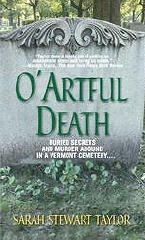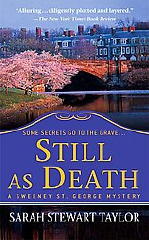Sun 28 Sep 2008
Review: SARAH STEWART TAYLOR – Judgment of the Grave.
Posted by Steve under Authors , Bibliographies, Lists & Checklists , Characters , ReviewsNo Comments
SARAH STEWART TAYLOR – Judgment of the Grave.
St. Martin’s; reprint paperback; 1st pr., Aug 2006. Hardcover edition: St. Martin’s; July 2005.
It is impossible to keep up. When I go looking for whatever book to read next, I often pick one out at random, and invariably it’s the second or third in a series, almost never the first. (I used to teach college courses in probability, so I’m not complaining. I know exactly what the odds are, and they’re against me.)
Judgment of the Grave is the third of four of the recorded adventures of Harvard-based art historian, Sweeney St. George. It’s early in this review, instead of at the end, where I often do it, but here’s a list of all four. All came out first from St. Martin’s in hardcover, then in paperback:
O’ Artful Death. 2003 / June 2004.

Mansions of the Dead. July 2004 / May 2005.
Judgment of the Grave. July 2005 / Aug 2006.
Still As Death. Sept 2006 / Oct 2007.
And in spite of excellent reviews and good sales rankings on Amazon, these four appear to be all there’s going to be. Sarah Stewart Taylor’s website does not seem to have been updated since October 2007 and the last entry in her blog is dated May 2, 2007.

That’s a shame. In spite of some quibbles which I’ll get to shortly, I enjoyed Judgment of the Grave quite thoroughly. So well, in fact, that if I knew where my copy was, I’d read Still As Death next, just to find out what happens to Sweeney and her romantic difficulties in her followup adventure. And failing that, go back and read one or both of the first two (see above), just to learn how all of her romantic difficulties began in the first place.
Quibbles: These very same Sweeney’s romantic difficulties — and all of the problems the other characters have in Judgment of the Grave. They’re a major part of the story, and they tend to overpower the detective story involved.
But what they also help create is a dark, atmospheric tale filled with angst, anxiety and sorrow, beginning with the opening scene (after a short prologue) in which Sweeney meets a young 12-year-old boy with leukemia while she’s researching gravestones in a Concord MA cemetery.
Cambridge police detective Tim Quinn, whom Sweeney has met before and seems to have a history with, meets her again as he follows up on a missing person’s report — a professor having a similar interest in gravestones and the history of the Revolutionary War has disappeared after taking part in a battle re-enactment up near Concord. Quinn’s wife committed suicide, we learn, and he’s forced to take his 10-month-old daughter along with him. Sweeney is a multi-tasker. She babysits and helps solve the mystery at the same time.

Meanwhile Sweeney’s almost-but-not-quite-affair with Ian has been put on hold while he’s home in England. Phone calls every night. I don’t quite understand where Toby fits in, but he somehow seems to have overnight privileges.
Also often crowding the mystery aside are long expository pages on the War of Independence, how it was conducted, how not all of the colonists were fighting for freedom, and how much the British depended on spies.
The latter may be the reason for the present day killings, or perhaps not, because all of the other character’s marriages are either broken or on the verge, and jealousy or revenge are also excellent reasons for murder. A veritable Peyton Place, without the same degree of notoriety or sensationalism.
I suppose you already know, having gotten this far, whether or not you will ever read any of the books in the series, but nonetheless, with a bit of pruning down and firming up, and filmed in black-and-white, or with dark, shadowy indoor scenes contrasted with the bright colors of an autumn New England sky, Judgment to the Grave would be as noirish as they come. It’s not Los Angeles, but there are a lot of dark secrets in Massachusetts too.
[COMMENT.] Later the same day. I’m embarrassed to point this out, but while searching for some more information about the author on Google, I discovered that I’d totally forgotten that Walter Albert reviewed this same book here on Mystery*File, and not too long ago.
He liked it too.